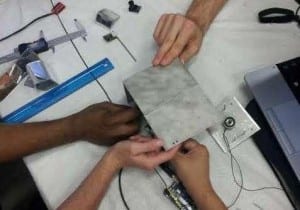UCF’s NanoRocks Return Promising Data
The University of Central Florida’s experiment NanoRocks, currently on board the International Space Station, is producing promising results.
The experiment studying solar system formation was taken to the space station through a NanoRacks partnership with Space Florida’s International Space Station Research Competition. NanoRocks is one of seven competition winners to be flown to low-earth orbit through the NanoRacks-Space Florida program.
“We’re pleased with the early data,” said UCF physics professor and project principal investigator Joshua Colwell. “This is exactly why scientific research in space is critical. There’s no way we could get the kind of data we are seeing from our NanoRocks experiment by doing it here on Earth. We need to study collisions at low speeds and without interference from Earth’s gravity, and that means space.”
The scientific motivation behind the NanoRocks experiment is to understand collisions that occur in the early stages of planet formation, both in our solar system and systems around other stars. Specifically, UCF is studying how these developing planets develop from just centimeters across to much larger objects, known as planetesimals, which are able to gravitationally attract to each other and form full-size planets.
“This is why space station utilization is so compelling,” said NanoRacks’ Dream-Up Director Patricia Mayes. “In a container the size of a soda bottle, these researchers are solving the mysteries of how our solar system formed. The research possibilities on ISS are endless when gravity is removed as a variable, and we love being the facilitator to this process.”
The experiment works like this. NanoRocks holds eight different sample trays, each holding different types and combinations of spherical particles (i.e., glass, acrylic, copper and rock). The experiment shakes the particle reservoir, allowing the particles to bump into each other. The particles’ mechanical energy is then dissipated into thermal energy, allowing the velocity to slow to near zero. The particles then move at speeds as slow as a fraction of a centimeter per second. The researchers at UCF can then measure speeds both before and after collisions, and the collisions where the particles stick together.
“Our company is thrilled to be facilitating onboard the space station a project that while small in size has infinite potential,” says NanoRacks’ CEO Jeffrey Manber.
Recently, NanoRacks was able to downlink video footage from within NanoRacks’ Frame 2, where the experiment is hosted aboard the space station, showing exactly how science experimentation happens in microgravity. The largest particles are two millimeters, and the smaller are just a fraction of a millimeter.
To watch videos of the NanoRocks click here and here.
To view the original article please visit UCF Today.

